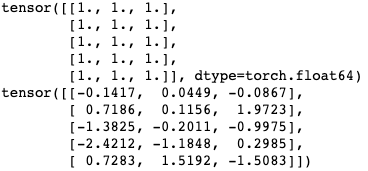pytorch入门
特点
支持GPU,灵活,支持动态神经网络,底层代码易于理解,命令式体验。
张量(tensor)学习
具体用法参照官方文档
1 | import torch |

1 | # 构造一个随机初始化的矩阵 |

1 | # 构造一个填充某个值的矩阵 |

1 | # 构造全为0的矩阵,且数据类型为long |

1 | # 构造单位矩阵 |

1 | # 使用数据构造一个张量 |

1 | # 用已经存在的tensor构造一个tensor |

1 | # 获取维度信息 size() |

1 | # 加法1 + |

1 | # 加法2 torch.add |

1 | # 提供一个输出tensor作为参数 |

1 | # add x to y (in-place) |

1 | # 改变大小:如果你想改变一个 tensor 的大小或者形状,你可以使用 torch.view: |
